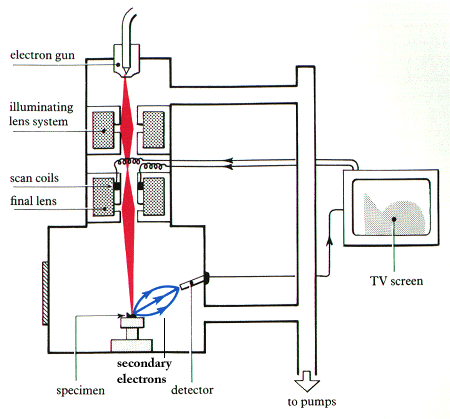|
The secondary electrons are selectively attracted to a grid held at a low (50
volt) positive potential with respect to the specimen. Behind the grid is a disc
held at about 10 kilovolts positive with respect to the specimen. The disc
consists of a layer of scintillant coated with a thin layer of aluminum. The
secondary electrons pass through the grid and strike the disc, causing the
emission of light from the scintillant. The light is led down a light pipe to a
photomultiplier tube which converts the photons of light into a voltage. The
strength of this voltage depends on the number of secondary electrons that are
striking the disc. Thus the secondary electrons produced from a small area of
the specimen give rise to a voltage signal of a particular strength. The voltage
is led out of the microscope column to an electronic console, where it is
processed and amplified to generate a point of brightness on a cathode ray tube
(or television) screen. An image is built up simply by scanning the electron
beam across the specimen in exact synchrony with the scan of the electron beam in
the cathode ray tube.
The SEM does not contain objective, intermediate and projector lenses to magnify
the image. Instead magnification results from the ratio of the area scanned on
the specimen to the area of the television screen. Increasing the magnification
in an SEM is therefore achieved quite simply by scanning the electron beam over a
smaller area of the specimen.
This description of image formation in the SEM is equally applicable to
elastically scattered electrons, X-rays, or photons of visible light - except
that the detection systems are different in each case. Secondary electron
imaging is the most common because it can be used with almost any specimen.
A modern trend in electron microscopy is to fit X-ray analysis equipment as a
bolt-on accessory. Bombarding a specimen with electrons causes X-rays of
characteristic wavelengths and energies to be emitted from the spot where the
beam strikes the specimen. Computer analysis of the wavelength or energy spectra
makes it possible to measure accurately the nature and quantity of different
elements in the material. The technique is of little use to biologists because
light elements such as carbon produce too weak an X-ray signal. But it is of
great value in materials science, particularly because an area as small as I
square micrometer can be analyzed with precision.
Since the output from the SEM is a train of voltages, the operator can exert
considerable control over the character of the image. Focus, magnification,
brightness and contrast can all be controlled just by turning knobs on the
console. In addition, the specimen can usually be tilted and rotated so that it
can be examined from a wide range of viewpoints. The output from the microscope
can be computer processed so that successive frames are combined and averaged,
producing a striking reduction in random noise levels.
Go back to the top of this page.
Go on to the next section, Biological Specimens.
Page authored by Paul Perkes and the ACEPT W3 Group
Department of Physics and Astronomy, Arizona State University, Tempe, AZ 85287-1504
Copyright © 1995-2000 Arizona Board of Regents. All rights reserved.
|

